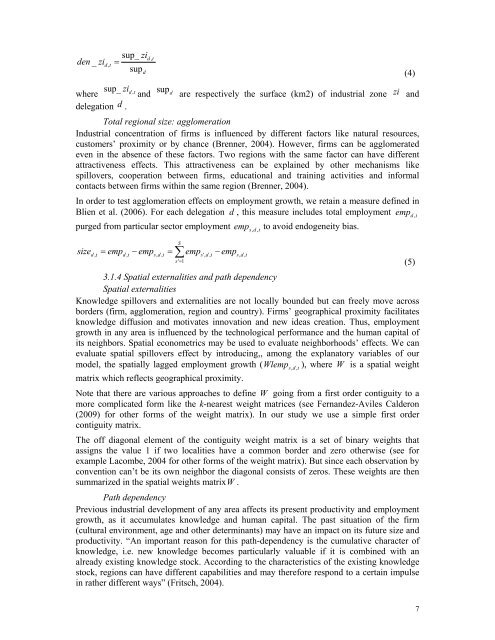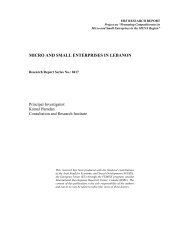local employment growth in the coastal area of tunisia - Economic ...
local employment growth in the coastal area of tunisia - Economic ...
local employment growth in the coastal area of tunisia - Economic ...
You also want an ePaper? Increase the reach of your titles
YUMPU automatically turns print PDFs into web optimized ePapers that Google loves.
sup_ zid<br />
, t<br />
den _ zid<br />
, t =<br />
supd<br />
(4)<br />
sup_ zi d , t sup<br />
where and d are respectively <strong>the</strong> surface (km2) <strong>of</strong> <strong>in</strong>dustrial zone zi and<br />
delegation d .<br />
Total regional size: agglomeration<br />
Industrial concentration <strong>of</strong> firms is <strong>in</strong>fluenced by different factors like natural resources,<br />
customers’ proximity or by chance (Brenner, 2004). However, firms can be agglomerated<br />
even <strong>in</strong> <strong>the</strong> absence <strong>of</strong> <strong>the</strong>se factors. Two regions with <strong>the</strong> same factor can have different<br />
attractiveness effects. This attractiveness can be expla<strong>in</strong>ed by o<strong>the</strong>r mechanisms like<br />
spillovers, cooperation between firms, educational and tra<strong>in</strong><strong>in</strong>g activities and <strong>in</strong>formal<br />
contacts between firms with<strong>in</strong> <strong>the</strong> same region (Brenner, 2004).<br />
In order to test agglomeration effects on <strong>employment</strong> <strong>growth</strong>, we reta<strong>in</strong> a measure def<strong>in</strong>ed <strong>in</strong><br />
Blien et al. (2006). For each delegation d , this measure <strong>in</strong>cludes total <strong>employment</strong> emp d , t<br />
purged from particular sector <strong>employment</strong> emp s,<br />
d , t to avoid endogeneity bias.<br />
size<br />
d , t<br />
= emp<br />
d , t<br />
− emp<br />
s,<br />
d , t<br />
=<br />
S<br />
∑<br />
s'=<br />
1<br />
emp<br />
s',<br />
d , t<br />
− emp<br />
s,<br />
d , t<br />
3.1.4 Spatial externalities and path dependency<br />
Spatial externalities<br />
Knowledge spillovers and externalities are not <strong>local</strong>ly bounded but can freely move across<br />
borders (firm, agglomeration, region and country). Firms’ geographical proximity facilitates<br />
knowledge diffusion and motivates <strong>in</strong>novation and new ideas creation. Thus, <strong>employment</strong><br />
<strong>growth</strong> <strong>in</strong> any <strong>area</strong> is <strong>in</strong>fluenced by <strong>the</strong> technological performance and <strong>the</strong> human capital <strong>of</strong><br />
its neighbors. Spatial econometrics may be used to evaluate neighborhoods’ effects. We can<br />
evaluate spatial spillovers effect by <strong>in</strong>troduc<strong>in</strong>g,, among <strong>the</strong> explanatory variables <strong>of</strong> our<br />
model, <strong>the</strong> spatially lagged <strong>employment</strong> <strong>growth</strong> ( Wlemp s,<br />
d , t ), where W is a spatial weight<br />
matrix which reflects geographical proximity.<br />
Note that <strong>the</strong>re are various approaches to def<strong>in</strong>e W go<strong>in</strong>g from a first order contiguity to a<br />
more complicated form like <strong>the</strong> k-nearest weight matrices (see Fernandez-Aviles Calderon<br />
(2009) for o<strong>the</strong>r forms <strong>of</strong> <strong>the</strong> weight matrix). In our study we use a simple first order<br />
contiguity matrix.<br />
The <strong>of</strong>f diagonal element <strong>of</strong> <strong>the</strong> contiguity weight matrix is a set <strong>of</strong> b<strong>in</strong>ary weights that<br />
assigns <strong>the</strong> value 1 if two <strong>local</strong>ities have a common border and zero o<strong>the</strong>rwise (see for<br />
example Lacombe, 2004 for o<strong>the</strong>r forms <strong>of</strong> <strong>the</strong> weight matrix). But s<strong>in</strong>ce each observation by<br />
convention can’t be its own neighbor <strong>the</strong> diagonal consists <strong>of</strong> zeros. These weights are <strong>the</strong>n<br />
summarized <strong>in</strong> <strong>the</strong> spatial weights matrixW .<br />
Path dependency<br />
Previous <strong>in</strong>dustrial development <strong>of</strong> any <strong>area</strong> affects its present productivity and <strong>employment</strong><br />
<strong>growth</strong>, as it accumulates knowledge and human capital. The past situation <strong>of</strong> <strong>the</strong> firm<br />
(cultural environment, age and o<strong>the</strong>r determ<strong>in</strong>ants) may have an impact on its future size and<br />
productivity. “An important reason for this path-dependency is <strong>the</strong> cumulative character <strong>of</strong><br />
knowledge, i.e. new knowledge becomes particularly valuable if it is comb<strong>in</strong>ed with an<br />
already exist<strong>in</strong>g knowledge stock. Accord<strong>in</strong>g to <strong>the</strong> characteristics <strong>of</strong> <strong>the</strong> exist<strong>in</strong>g knowledge<br />
stock, regions can have different capabilities and may <strong>the</strong>refore respond to a certa<strong>in</strong> impulse<br />
<strong>in</strong> ra<strong>the</strong>r different ways” (Fritsch, 2004).<br />
(5)<br />
7

















